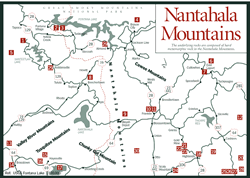 Fontana
Lake
Fontana
Lake  Fontana
Lake
Fontana
Lake [Fig. 32] Nestled in the shadow of the Great Smoky Mountains, the limpid waters of Fontana Lake (the largest lake in Western North Carolina) reflect the splendor of those ancient knobs and peaks. Don't be surprised if the spectacular views hereabouts seem strangely familiar: portions of several recent films, including Nell and The Fugitive, were shot here. Today, Fontana and environs constitute a world-class playground, drawing boaters, fishing enthusiasts, hikers, and mountain bikers from far and near.
Ironically, the peaceful vistas created by the lake are actually the fruits of war. Fontana was built in the wake of the Japanese attack on Pearl Harbor, to provide power for the war effort (specifically, Oak Ridge, Tennessee, where top-secret work on the atomic bomb was being conducted under heavy security). When the Tennessee Valley Authority completed the 480-foot-tall Fontana Dam late in 1944, it was the fourth largest hydroelectric facility in the world.
Today, those wartime concerns seem remote. Fontana Village—built to house the thousands of workers who labored round the clock, seven days a week to complete the dam in record time—is now the most comprehensive, year-round family resort in the Smokies, boasting a range of lodgings (from campsites to cottages to a full-service inn), extensive sport facilities, and more traditional activities (including classes in Appalachian crafts, music, and clogging). Fontana Village Resort offers 30 miles of mountain biking trails, as well as horseback riding and even escorted hikes.
 But
the lake itself remains the main attraction. Held back by the massive dam (the
highest east of the Mississippi), the waters of the Little Tennessee River spread
out along the coves and inlets to create the 29-mile-long artificial lake with
its 240-mile rugged shoreline. Two other rivers, the Nantahala and the Tuckasegee,
also feed the lake, as do numerous creeks descending from the Smokies to the
north and from the geologic jumble of the Yellow Creek, Cheoah, and Nantahala
mountains to the south.
But
the lake itself remains the main attraction. Held back by the massive dam (the
highest east of the Mississippi), the waters of the Little Tennessee River spread
out along the coves and inlets to create the 29-mile-long artificial lake with
its 240-mile rugged shoreline. Two other rivers, the Nantahala and the Tuckasegee,
also feed the lake, as do numerous creeks descending from the Smokies to the
north and from the geologic jumble of the Yellow Creek, Cheoah, and Nantahala
mountains to the south.
Geologically, the area around Fontana Dam is similar to what one finds in most of the neighboring Smokies, including dark black slates and schists. Copper was mined along Eagle Creek (on the Smokies side) from 1927 until the dam was built. The sulfidic rock formations common in the area are what road builders call "hot rock": when exposed by construction, they can produce acid runoff, which eats through drain pipes and culverts and can be lethal to aquatic life and roadside vegetation.
Among the area's more intriguing geologic features are the Indian Caves in the lower Nantahala Gorge, just above the eastern end of the lake. The caves, a series of connected chambers scoured out of the Nantahala slate cliffs, were sacred to the Cherokee and later housed workers building the rail line through the gorge. The caves are located near the foot bridge on US 19, about 50 yards north of the tracks.
Warbler watchers will be in seventh heaven here—in the summer, the area hosts more than 20 species, including Cerulean (Dendroica cerulea), black-throated green (D. virens), yellow-throated (D. dominica), golden-winged (Vermivora chrysoptera), blue-winged (V. pinus), worm-eating (Helmitheros vermivorus), and Swainson's (Limnothlypis swainsonii). Spring and summer are the best times, though there are birding opportunities year-round along NC 28 and other local roads. Look for the bulb-shaped nests of the cliff swallow (Petrochelidon pyrrhonota) in the shelter of Fontana Dam.
The Nantahala Mountains—which run north from the Georgia border for about 25 miles, terminating near Fontana's eastern end—also offer diverse birding opportunities, with less competition from fellow bird lovers. Away from the lake, try the central Nantahalas, especially the area around Wayah Gap (see Wayah Bald).
The last known mountain lion (Felis concolor) in the Smokies was killed near Fontana Village, though unconfirmed sightings are periodically reported within the park boundaries.
Not surprisingly, Fontana Lake is best known for its recreational opportunities. Walleye, three kinds of bass—smallmouth (Micropterus dolomieui), largemouth (M. salmoides), and white (Morone chrysops)—as well as channel catfish (Ictalurus punctatus), flathead catfish (Pylodictis olivaris), and bluegill (Lepomis macrochirus) are abundant. Trout thrive in the many streams that feed the lake on the Smokies side. A state-record, 41-pound muskellunge (Esox masquinongy) was nabbed here in 1994. Two sites along NC 28, Tsali and Cable Cove recreation areas [Fig. 32(2,3)] (see below), provide access to the lake, as well as hiking, camping, and biking opportunities. (Directions to these and other local attractions may change as the four-laning of NC 28 is carried out over the next several years.)
The Appalachian Trail runs across Fontana Dam. Hikers might also explore a number of connected trails out of Fontana Village, including the Look (or Lookout) Rock Trail (off NC 1246, at the far end of Fontana Village) and the Lewellyn Cove Nature Trail, which features 50 trees and shrubs labeled for easy identification. Ask at the front desk for a free trail map and written material about these and other Fontana trails.